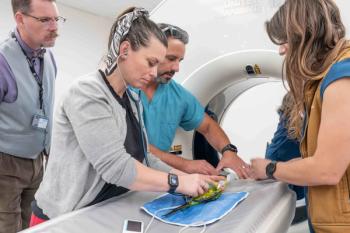
Myelography: Still helpful or too risky because of seizures?
A recent study sought to establish the incidence of and risk factors for seizures after myelography with iohexol in dogs.
Myelography is an imaging examination that involves introducing a spinal needle into the cervical or lumbar spinal canal and injecting contrast material in the subarachnoid space (space around the spinal cord). Subsequent radiographic examination can detect pathology in the spinal cord and identify the location of spinal cord injury. In some cases, a myelogram may help find the cause and location of spinal cord or nerve root injury not found by magnetic resonance imaging or computed tomography.
Golden findings: This studyâs results can help you perform this procedure safely in all dogs.
The presence of a contrast agent such as iohexol in the subarachnoidal space may be associated with damage to the nervous tissue, and injection of contrast agent into the spinal cord may result in cardiorespiratory problems, seizures or death.
Research findings
A recent study sought to establish the incidence of and risk factors for seizures after myelography with iohexol in dogs.1 In this retrospective case study, myelography was performed in 503 dogs by using iohexol (240 mg iodine/ml) injected into the cerebellomedullary cistern, lumbar cistern or both. Opioids (hydromorphone, oxymorphone or morphine), diazepam or acepromazine was given for premedication.
Anesthesia was induced with propofol and maintained with isoflurane. The length of anesthesia ranged from 0.5 to 8.25 hours from injection of iohexol to the time of extubation. Fifteen (3 percent) had postmyelographic seizures. The seizures stopped either spontaneously or were controlled with diazepam, with the exception of one dog that required propofol to manage the seizure activity.
Dogs receiving injections into the cerebellomedullary cistern had a significantly (P < 0.001) higher risk of seizures compared with those that received injections into the lumbar cistern. Twelve of the dogs that experienced postmyelographic seizures had been injected with more than 8 ml of iohexol.
These observations are in agreement with a previous study that stated that it is best to inject iohexol in the L5-L6 intervertebral space to minimize the risk of seizures.2
Higher prevalence of seizures in large dogs, compared with smaller dogs, may be caused by administration of larger total volumes of contrast agent per volume of cerebrospinal fluid.
In the present study, there was no significant predisposing effect of acepromazine on the incidence of postmyelographic seizures. In the past, acepromazine has been incriminated as a predisposing factor to seizures, ostensibly because this compound can decrease the seizure threshold.
The findings also suggested that postmyelographic seizures might be less likely with longer duration rather than shorter duration anesthesia. Furthermore, dogs with lesions in the cervical portion of the vertebral column were 4.65 times as likely to have a seizure compared with dogs with lesions in other regions.
Conclusion
The incidence of seizures with myelography is low, so this imaging examination technique is a relatively safe diagnostic procedure. The chances of postmyelographic seizures in a small-breed dog with a thoracolumbar lesion having lumbar myelography would be low. A large-breed dog with a cervical lesion and contrast medium injection in the cerebellomedullary cistern would be at higher risk. The risk of seizure may be minimized in large-breed dogs by not injecting more than 8 ml of iohexol and by injecting into the lumbar cistern.
Myelography remains one of the most important diagnostic techniques in clinical neurology. This imaging examination is particularly useful in identifying dynamic spinal disorders (e.g., wobbler syndrome) that may be identified when comparing myelographic images of the spine maintained in different positions (e.g., flexed or extended). Secondary effects of a myelogram are mild and short-lasting in most cases. Myelography is also a sensitive diagnostic tool for most spinal cord diseases.
Dr. Bichsel completed his residency in neurology at the University of Georgia in 1984. He is a diplomate of the American College of Veterinary Internal Medicine and works at the Animal Emergency and Referral Center in Ft. Pierce, Fla.
Dr. Lyman is a graduate of The Ohio State University College of Veterinary Medicine. He completed a formal internship at the Animal Medical Center in New York City. Lyman is a co-author of chapters in the 2000 editions of Kirk's Current Veterinary Therapy XIII and Quick Reference to Veterinary Medicine.
References
1. daCosta RC, Parent JM, Dobson H. Incidence of and risk factors for seizures after myelography performed with iohexol in dogs: 503 cases (2002-2004). J Am Vet Med Assoc 2011;238(10):1296-1300.
2. Barone G, Ziemer LS, Shofer FS, et al. Risk factors associated with development of seizures after use of iohexol for myelography in dogs: 182 cases (1998). J Am Vet Med Assoc 2002;220(10):1499-1502.
Newsletter
From exam room tips to practice management insights, get trusted veterinary news delivered straight to your inbox—subscribe to dvm360.






